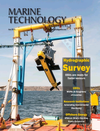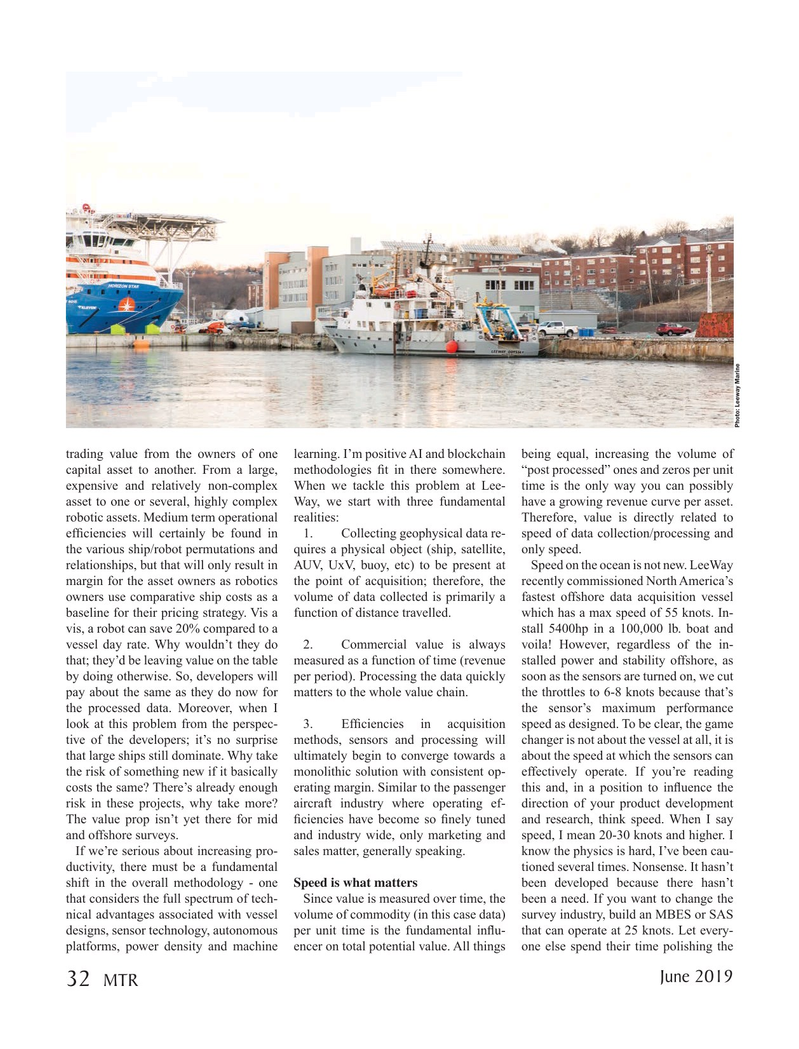
Page 32: of Marine Technology Magazine (June 2019)
Hydrographic Survey: Single & Multibeam Sonar
Read this page in Pdf, Flash or Html5 edition of June 2019 Marine Technology Magazine
Photo: Leeway Marine trading value from the owners of one learning. I’m positive AI and blockchain being equal, increasing the volume of capital asset to another. From a large, methodologies ? t in there somewhere. “post processed” ones and zeros per unit expensive and relatively non-complex When we tackle this problem at Lee- time is the only way you can possibly asset to one or several, highly complex Way, we start with three fundamental have a growing revenue curve per asset. robotic assets. Medium term operational realities: Therefore, value is directly related to ef? ciencies will certainly be found in 1. Collecting geophysical data re- speed of data collection/processing and the various ship/robot permutations and quires a physical object (ship, satellite, only speed. relationships, but that will only result in AUV, UxV, buoy, etc) to be present at Speed on the ocean is not new. LeeWay margin for the asset owners as robotics the point of acquisition; therefore, the recently commissioned North America’s owners use comparative ship costs as a volume of data collected is primarily a fastest offshore data acquisition vessel baseline for their pricing strategy. Vis a function of distance travelled. which has a max speed of 55 knots. In- vis, a robot can save 20% compared to a stall 5400hp in a 100,000 lb. boat and vessel day rate. Why wouldn’t they do 2. Commercial value is always voila! However, regardless of the in- that; they’d be leaving value on the table measured as a function of time (revenue stalled power and stability offshore, as by doing otherwise. So, developers will per period). Processing the data quickly soon as the sensors are turned on, we cut pay about the same as they do now for matters to the whole value chain. the throttles to 6-8 knots because that’s the processed data. Moreover, when I the sensor’s maximum performance look at this problem from the perspec- 3. Ef? ciencies in acquisition speed as designed. To be clear, the game tive of the developers; it’s no surprise methods, sensors and processing will changer is not about the vessel at all, it is that large ships still dominate. Why take ultimately begin to converge towards a about the speed at which the sensors can the risk of something new if it basically monolithic solution with consistent op- effectively operate. If you’re reading costs the same? There’s already enough erating margin. Similar to the passenger this and, in a position to in? uence the risk in these projects, why take more? aircraft industry where operating ef- direction of your product development
The value prop isn’t yet there for mid ? ciencies have become so ? nely tuned and research, think speed. When I say and offshore surveys. and industry wide, only marketing and speed, I mean 20-30 knots and higher. I
If we’re serious about increasing pro- sales matter, generally speaking. know the physics is hard, I’ve been cau- ductivity, there must be a fundamental tioned several times. Nonsense. It hasn’t shift in the overall methodology - one Speed is what matters been developed because there hasn’t that considers the full spectrum of tech- Since value is measured over time, the been a need. If you want to change the nical advantages associated with vessel volume of commodity (in this case data) survey industry, build an MBES or SAS designs, sensor technology, autonomous per unit time is the fundamental in? u- that can operate at 25 knots. Let every- platforms, power density and machine encer on total potential value. All things one else spend their time polishing the
June 2019 32 MTR
MTR #5 (18-33).indd 32 5/24/2019 2:23:48 PM

 31
31

 33
33
